Fabrication and Characteristics of a Conductive FeCo@Au Nanowire Alloy for Semiconductor Test Socket Connectors
Abstract
:1. Introduction
2. Materials and Methods
2.1. Formation of FeCo Nanowires and Au Coating
2.2. Characterization of FeCo@Au NWs
2.3. Fabrication of Semiconductor Test Connectors
3. Results and Discussion
4. Conclusions
5. Patents
Supplementary Materials
Author Contributions
Funding
Institutional Review Board Statement
Informed Consent Statement
Data Availability Statement
Acknowledgments
Conflicts of Interest
References
- Weifeng, L.; Mikyoung, L.; Pecht, M.; Martens, R. An investigation of the contact resistance of a commercial elastomer interconnect under thermal and mechanical stresses. IEEE Trans. Device Mater. Reliab. 2003, 3, 39–43. [Google Scholar] [CrossRef]
- Kim, H.; Bae, B.; Kim, J.J.; Park, J.; Ha, D.; Bae, M.; Kim, J. Modeling and analysis of a conductive rubber contactor for package test. In Proceedings of the 2015 IEEE 17th Electronics Packaging and Technology Conference (EPTC), Singapore, 2–4 December 2015; pp. 1–4. [Google Scholar]
- Park, J.; Kim, H.; Kim, J.J.; Kim, D.-H.; Son, K.; Kim, S.; Lee, S.; Cho, K.; Bae, B.; Ha, D.; et al. High-Frequency Electrical Characterization of a New Coaxial Silicone Rubber Socket for High-Bandwidth and High-Density Package Test. IEEE Trans. Compon. Packag. Manuf. Technol. 2018, 8, 2152–2162. [Google Scholar] [CrossRef]
- Kim, I.-H.; Jeon, B.-S.; Lee, T.-H.; Song, C.-B. Study on the Fabrication of Electric Conductivity Fe-Cu-X System Alloy for IC Semiconductor Test Socket. J. Korean Magn. Soc. 2021, 31, 322–327. [Google Scholar] [CrossRef]
- Reddyprakash, M.; Kim, D.; Choi, W.J.; Yun, J.H.; Loka, C.; Lee, K.S. Fabrication of Pressure Conductive Silicone Rubber Socket Device by Shape-Controlled Nickel Powders Produced by High-Energy Ball Milling. Materials 2022, 15, 6670. [Google Scholar] [CrossRef]
- Ruey-Bo, S.; Ruey-Beei, W.; Shih-Wei, H. Compromised impedance match design for signal integrity of pogo pins structures with different signal-ground patterns. In Proceedings of the 2009 IEEE Workshop on Signal Propagation on Interconnects, Strasbourg, France, 12–15 May 2009; pp. 1–4. [Google Scholar]
- Muhammad Idzdihar, I.; Nowshad, A.; Faiz, A.; Siti Amaniah, M.C. Deposition of Micro Contact Based Probe Cell for IC Testing by Dc Magnetron Sputtering Technique. Res. J. Appl. Sci. Eng. Technol. 2014, 7, 2701–2704. [Google Scholar] [CrossRef]
- Hong, S. Memory technology trend and future challenges. In Proceedings of the 2010 International Electron Devices Meeting, San Francisco, CA, USA, 6–8 December 2010; pp. 12.1.4–12.4.4. [Google Scholar]
- Yeap, G. Smart mobile SoCs driving the semiconductor industry: Technology trend, challenges and opportunities. In Proceedings of the 2013 IEEE International Electron Devices Meeting, Washington, DC, USA, 9–11 December 2013; pp. 1.3.1–1.3.8. [Google Scholar]
- Carballo, J.-A.; Chan, W.-T.J.; Gargini, P.A.; Kahng, A.B.; Nath, S. ITRS 2.0: Toward a re-framing of the Semiconductor Technology Roadmap. In Proceedings of the 2014 IEEE 32nd International Conference on Computer Design, Seoul, Republic of Korea, 19–22 October 2014; pp. 139–146. [Google Scholar]
- Park, J.; Kim, H.; Kim, Y.; Kim, J.J.; Bae, B.; Kim, J.; Ha, D.; Bae, M. Analysis of external force dependent lumped RLGC model of high-bandwidth and high-density silicone rubber socket. In Proceedings of the 2015 IEEE Electrical Design of Advanced Packaging and Systems, Seoul, Republic of Korea, 14–16 December 2015; pp. 54–57. [Google Scholar]
- Park, J.; Kim, H.; Kim, J.J.; Bae, B.; Ha, D.; Bae, M.; Kim, J. Measurement of High-Bandwidth and High-Density Silicone Rubber Socket up to 110GHz. In Proceedings of the 2016 IEEE 66th Electronic Components and Technology Conference, Las Vegas, NV, USA, 31 May–3 June 2016; pp. 2481–2486. [Google Scholar]
- Kim, H.; Kim, J.J.; Park, J.; Park, S.; Choi, S.; Bae, B.; Ha, D.; Bae, M.; Kim, J. High-Frequency Modeling and Signal Integrity Analysis of a Silicone Rubber Socket for High-Performance Package. IEEE Trans. Compon. Packag. Manuf. Technol. 2017, 7, 1356–1368. [Google Scholar] [CrossRef]
- Wang, D.; Zhang, Y.; Chen, J.; Xu, H.; Qin, L.; Li, Y.; Zhang, W.; Zhang, P.; Tian, W.; Guo, X. Structural hybridization of ternary (0D, 1D and 2D) composites as anodes for high-performance Li-ion batteries. Energy Storage Mater. 2018, 13, 293–302. [Google Scholar] [CrossRef]
- Wang, Z.; Lu, Y. Facile Construction of High-Performance Amorphous FePO4Carbon Nanomaterials as Cathodes of Lithium-Ion Batteries. ACS Appl. Mater. Interfaces 2019, 11, 13225–13233. [Google Scholar] [CrossRef]
- Yang, X.; Zhang, R.; Xu, S.; Xu, D.; Ma, J.; Wang, S. Effect of carbon dimensions on the electrochemical performance of SnSe2 anode for Na-ion batteries. Mater. Lett. 2021, 284, 128989. [Google Scholar] [CrossRef]
- Askeland, D.R.; Fulay, P.P.; Wright, W.J. The Science and Engineering of Materials, 6th ed.; Cengage Learning: Boston, MA, USA, 2010. [Google Scholar]
- Shokrollahi, H.; Janghorban, K. Soft magnetic composite materials (SMCs). J. Mater. Process. Technol. 2007, 189, 1–12. [Google Scholar] [CrossRef]
- Krings, A.; Cossale, M.; Tenconi, A.; Soulard, J.; Cavagnino, A.; Boglietti, A. Magnetic materials used in electrical machines: A comparison and selection guide for early machine design. IEEE Ind. Appl. Mag. 2017, 23, 21–28. [Google Scholar] [CrossRef] [Green Version]
- Hu, F.; Ni, J.L.; Feng, S.J.; Kan, X.C.; Zhu, R.W.; Yang, W.; Yang, Y.J.; Lv, Q.R.; Liu, X.S. Low melting glass as adhesive and insulating agent for soft magnetic composites: Case in FeSi powder core. J. Magn. Magn. Mater. 2020, 501, 166480. [Google Scholar] [CrossRef]
- Li, Q.W.; Li, Y.; Zhang, X.F.; Chikkannanavar, S.B.; Zhao, Y.H.; Dangelewicz, A.M.; Zheng, L.X.; Doorn, S.K.; Jia, Q.X.; Peterson, D.E.; et al. Structure-Dependent Electrical Properties of Carbon Nanotube Fibers. Adv. Mater. 2007, 19, 3358–3363. [Google Scholar] [CrossRef]
- Zafer Balbağ, M.; Pat, S. Electrically conductive and optically transparent polyethylene terephthalate films coated with gold and silver by thermionic vacuum arc. J. Plast. Film Sheeting 2011, 27, 209–222. [Google Scholar] [CrossRef]
- Wang, M.; Wang, L.-D.; Sheng, J.; Yang, Z.-Y.; Shi, Z.-D.; Zhu, Y.-P.; Li, J.; Fei, W.-D. Direct synthesis of high-quality graphene on Cu powders from adsorption of small aromatic hydrocarbons: A route to high strength and electrical conductivity for graphene/Cu composite. J. Alloy. Compd. 2019, 798, 403–413. [Google Scholar] [CrossRef]
- Zhang, J.; Liang, M.; Hu, Q.; Ma, F.; Li, Z.; Wang, Y.; Wang, L.; Zhang, S. Cu@Ag nanoparticles doped micron-sized Ag plates for conductive adhesive with enhanced conductivity. Int. J. Adhes. Adhes. 2020, 102, 102657. [Google Scholar] [CrossRef]
- Huang, J.; Han, X.; Wang, D.; Liu, D.; You, T. Facile synthesis of dendritic gold nanostructures with hyperbranched architectures and their electrocatalytic activity toward ethanol oxidation. Int. J. Adhes. Adhes. 2013, 5, 9148–9154. [Google Scholar] [CrossRef]
- Umeya, Y.; Kobayashi, Y.; Kawashimo, T.; Ahn, S.; Chang, G.; Oyama, M. Preparation of gold modified nickel wire electrodes for electroanalysis via a galvanic replacement reaction. Electroanalysis 2018, 30, 1370–1377. [Google Scholar] [CrossRef]
- De Souza, R.M.; Saraceno, A.L.; Duyck, C.; da Silveira, C.L.P.; Aucélio, R.Q. Determination of Fe, Ni and V in asphaltene by ICP OES after extraction into aqueous solutions using sonication or vortex agitation. Microchem J. 2007, 87, 99–103. [Google Scholar] [CrossRef]
- Shrestha, P.; Holland, T.M.; Bundy, B.C. Streamlined extract preparation for Escherichia coli-based cell-free protein synthesis by sonication or bead vortex mixing. Biotechniques 2012, 53, 163–174. [Google Scholar] [CrossRef]
- Malhotra, D.; Mukherjee, J.; Gupta, M.N. Post-ultrasonic irradiation time is important in initiating citrate-coated α-Fe2O3 nanorod formation. RSC Adv. 2013, 3, 14322. [Google Scholar] [CrossRef]
- Falsafi, S.R.; Maghsoudlou, Y.; Rostamabadi, H.; Rostamabadi, M.M.; Hamedi, H.; Hosseini, S.M.H. Preparation of physically modified oat starch with different sonication treatments. Food Hydrocoll. 2019, 89, 311–320. [Google Scholar] [CrossRef]
- Adamski, M.; Peressin, N.; Balogun, E.; Pollet, B.G.; Holdcroft, S. Does power ultrasound affect hydrocarbon Ionomers? Ultrason. Sonochem. 2021, 75, 105588. [Google Scholar] [CrossRef] [PubMed]
- Saffman, P.; Baker, G. Vortex interactions. Annu. Rev. Fluid Mech. 1979, 11, 95–121. [Google Scholar] [CrossRef]
- Jana, S.C.; Metcalfe, G.; Ottino, J. Experimental and computational studies of mixing in complex Stokes flows: The vortex mixing flow and multicellular cavity flows. J. Fluid Mech. 1994, 269, 199–246. [Google Scholar] [CrossRef]
- Thanh, N.T.K.; Maclean, N.; Mahiddine, S. Mechanisms of Nucleation and Growth of Nanoparticles in Solution. Chem. Rev. 2014, 114, 7610–7630. [Google Scholar] [CrossRef]
- Lee, J.; Yang, S. Antisolvent Sonocrystallisation of Sodium Chloride and the Evaluation of the Ultrasound Energy Using Modified Classical Nucleation Theory. Crystals 2018, 8, 320. [Google Scholar] [CrossRef] [Green Version]
- Zehani, K.; Bez, R.; Boutahar, A.; Hlil, E.K.; Lassri, H.; Moscovici, J.; Mliki, N.; Bessais, L. Structural, magnetic, and electronic properties of high moment FeCo nanoparticles. J. Alloy. Compd. 2014, 591, 58–64. [Google Scholar] [CrossRef]
- Arief, I.; Biswas, S.; Bose, S. Tuning the Shape Anisotropy and Electromagnetic Screening Ability of Ultrahigh Magnetic Polymer and Surfactant-Capped FeCo Nanorods and Nanocubes in Soft Conducting Composites. ACS Appl. Mater. Interfaces 2016, 8, 26285–26297. [Google Scholar] [CrossRef]
- Rajesh, P.; Sellaiyan, S.; Uedono, A.; Arun, T.; Joseyphus, R.J. Positron Annihilation Studies on Chemically Synthesized FeCo Alloy. Sci Rep. 2018, 8, 9764. [Google Scholar] [CrossRef]
- Dias, D.F.; Braga, T.P.; Soares, J.M.; Sasaki, J.M. Structural, Morphological and Magnetic Properties of FeCo-(Fe,Co)3O4 Nanocomposite Synthesized by Proteic Sol-Gel Method Using a Rotary Oven. Mater. Res. 2019, 22, e20180446. [Google Scholar] [CrossRef]
- Shen, J.; Gong, M.; Dai, Q.; Ren, S. Surface-Stress-Induced Phase Transformation of Ultrathin FeCo Nanowires. ACS Appl. Mater. Interfaces 2016, 8, 31–36. [Google Scholar] [CrossRef] [PubMed]
- Bayev, V.G.; Fedotova, J.A.; Vorobyova, S.A.; Svito, I.A.; Ivashkevich, O.A.; Tyutyunnikov, S.I.; Kolobylina, N.N.; Guryeva, P.V. Mössbauer spectroscopy and magnetometry of FeCo-Ag and FeCo-Au nanocomposites synthesized by a redox-transmetalation method. Mater. Chem. Phys. 2018, 216, 349–353. [Google Scholar] [CrossRef]
- Hong, Y.; Choi, I.A.; Seo, W.S. Au nanoparticle@hollow mesoporous carbon with FeCo/graphitic shell nanoparticls as a magnetically recyclable yolk-shell nanocatalyst for catalytic reduction of nitroaromatics. Sci. Rep. 2018, 8, 7469. [Google Scholar] [CrossRef] [Green Version]
- Cabral, L.; Aragon, F.H.; Villegas-Lelovsky, L.; Lima, M.P.; Macedo, W.A.A.; Da Silva, J.L.F. Tuning the Magnetic Properties of FeCo Thin Films through the Magnetoelastic Effect Induced by the Au Underlayer Thickness. ACS Appl. Mater. Interfaces 2019, 11, 1529–1537. [Google Scholar] [CrossRef] [PubMed]
- Geng, G.; Chen, P.; Guan, B.; Liu, Y.; Yang, C.; Wang, N.; Liu, M. Sheetlike gold nanostructures/graphene oxide composites via a one-pot green fabrication protocol and their interesting two-stage catalytic behaviors. RSC Adv. 2017, 7, 51838–51846. [Google Scholar] [CrossRef] [Green Version]
- Woo, H.; Kim, E.; Kim, J.H.; Yun, S.W.; Park, J.C.; Kim, Y.T.; Park, K.H. Shape and Composition Control of Monodisperse Hybrid Pt-CoO Nanocrystals by Controlling the Reaction Kinetics with Additives. Sci. Rep. 2017, 7, 3851. [Google Scholar] [CrossRef]
- Yan, J.; Huang, Y.; Liu, P.; Wei, C. Large-scale controlled synthesis of magnetic FeCo alloy with different morphologies and their high performance of electromagnetic wave absorption. J. Mater. Sci. Mater. Electron. 2017, 28, 3159–3167. [Google Scholar] [CrossRef]
- Zhang, H.; Zheng, J.; Chao, Y.; Zhang, K.; Zhu, Z. Surface engineering of FeCo-based electrocatalysts supported on carbon paper by incorporating non-noble metals for water oxidation. New J. Chem. 2018, 42, 7254–7261. [Google Scholar] [CrossRef]
- Zhang, X.; Liu, Y.; Yang, X.; Li, J. Preparation and magnetic properties of electrospun FeCo nanofibres. Micro Nano Lett. 2012, 7, 907–909. [Google Scholar] [CrossRef]
- Popova, A.N.; Zaharov, Y.A.; Pugachev, V.M. Chemical synthesis, structure and magnetic properties of nanocrystalline Fe-Co alloys. Mater. Lett. 2012, 74, 173–175. [Google Scholar] [CrossRef]
- Wei, X.-W.; Zhu, G.-X.; Liu, Y.-J.; Ni, Y.-H.; Song, Y.; Xu, Z. Large-Scale Controlled Synthesis of FeCo Nanocubes and Microcages by Wet Chemistry. Chem. Mat. 2008, 20, 6248–6253. [Google Scholar] [CrossRef]
- Yan, Q.; Li, S.; Pang, E.; Wang, Y. Fabrication of hollow spheres FeCo alloy through a hydrothermal reduction method. Mater. Lett. 2014, 120, 185–188. [Google Scholar] [CrossRef]
- Gandha, K.; Tsai, P.; Chaubey, G.; Poudyal, N.; Elkins, K.; Cui, J.; Liu, J.P. Synthesis and characterization of FeCo nanowires with high coercivity. Nanotechnology 2015, 26, 075601. [Google Scholar] [CrossRef] [PubMed]
- Sánchez-De Jesús, F.; Bolarín-Miró, A.M.; Cortés Escobedo, C.A.; Torres-Villaseñor, G.; Vera-Serna, P. Structural Analysis and Magnetic Properties of FeCo Alloys Obtained by Mechanical Alloying. J. Metall. 2016, 2016, 1–8. [Google Scholar] [CrossRef]
- Chaudhary, V.; Sai Kiran Kumar Yadav, N.M.; Mantri, S.A.; Dasari, S.; Jagetia, A.; Ramanujan, R.V.; Banerjee, R. Additive manufacturing of functionally graded Co–Fe and Ni–Fe magnetic materials. J. Alloy. Compd. 2020, 823, 153817. [Google Scholar] [CrossRef]
- Kozlovskiy, A.; Zdorovets, M.; Kadyrzhanov, K.; Korolkov, I.; Rusakov, V.; Nikolaevich, L.; Fesenko, O.; Budnyk, O.; Yakimchuk, D.; Shumskaya, A.; et al. FeCo nanotubes: Possible tool for targeted delivery of drugs and proteins. Appl. Nanosci. 2019, 9, 1091–1099. [Google Scholar] [CrossRef]
- Guzmán-Mínguez, J.C.; Ruiz-Gómez, S.; Vicente-Arche, L.M.; Granados-Miralles, C.; Fernández-González, C.; Mompeán, F.; García-Hernández, M.; Erohkin, S.; Berkov, D.; Mishra, D.; et al. FeCo Nanowire–Strontium Ferrite Powder Composites for Permanent Magnets with High-Energy Products. ACS Appl. Nano Mater. 2020, 3, 9842–9851. [Google Scholar] [CrossRef]
- Chaubey, G.S.; Bárcena, C.; Poudyal, N.; Rong, C.; Gao, J.; Sun, S.; Liu, J.P. Synthesis and stabilization of FeCo nanoparticles. J. Am. Chem. Soc. 2007, 12923, 7214–7215. [Google Scholar] [CrossRef]
- Zhang, Z.; Zhang, J.; Thenuwara, A.C.; Strongin, D.R.; Sun, Y.; Ren, S. Structure and Magnetism Evolution from FeCo Nanoparticles to Hollow Nanostructure Conversion for Magnetic Applications. ACS Appl. Nano Mater. 2018, 1, 5837–5842. [Google Scholar] [CrossRef]
- Lin, Y.F.; Chen, H.W.; Chien, P.S.; Chiou, C.S.; Liu, C.C. Application of bifunctional magnetic adsorbent to adsorb metal cations and anionic dyes in aqueous solution. J. Hazard. Mater. 2011, 185, 1124–1130. [Google Scholar] [CrossRef] [PubMed]
- Fahmiati, F.; Nuryono, N.; Suyanta, S. Functionalization of Silica Coated on Iron Sand Magnetic Material with Diethylenetriamine. Asian J. Chem. 2018, 30, 1805–1810. [Google Scholar] [CrossRef]
- Marandi, A.; Koukabi, N. Fe3O4@TEA core-shell nanoparticles decorated palladium: A highly active and magnetically separable nanocatalyst for the Heck coupling reaction. Colloids Surf. A Physicochem. Eng. Asp. 2021, 621, 126597. [Google Scholar] [CrossRef]
- Yamoah, N.K.; Koten, M.A.; Thompson, D.; Nannuri, C.; Narayan, J.; Shield, J.E.; Kumar, D. Dependence of grain size and defect density on the magnetic properties of mechanically alloyed Fe90W10 powder. J. Appl. Phys. 2016, 120, 143903. [Google Scholar] [CrossRef]
- Syazwan, M.M.; Hapishah, A.N.; Azis, R.S.; Abbas, Z.; Hamidon, M.N. Grain growth effects on magnetic properties of Ni0.6Zn0.4Fe2O4 material prepared using mechanically alloyed nanoparticles. Results Phys. 2018, 9, 842–850. [Google Scholar] [CrossRef]
- Park, B.C.; Cho, J.; Kim, M.S.; Ko, M.J.; Pan, L.; Na, J.Y.; Kim, Y.K. Strategy to control magnetic coercivity by elucidating crystallization pathway-dependent microstructural evolution of magnetite mesocrystals. Nat. Commun. 2020, 11, 1–10. [Google Scholar] [CrossRef]
- Rubber lnterposers. Available online: http://www.evenfly.com.tw/h/ServiceDetail?key=31fcd&cont=293941 (accessed on 21 November 2022).
- Features (Test Rubber Socket). Available online: https://mslltd.co.kr/kor/technology/menu_05_1.html (accessed on 21 November 2022).
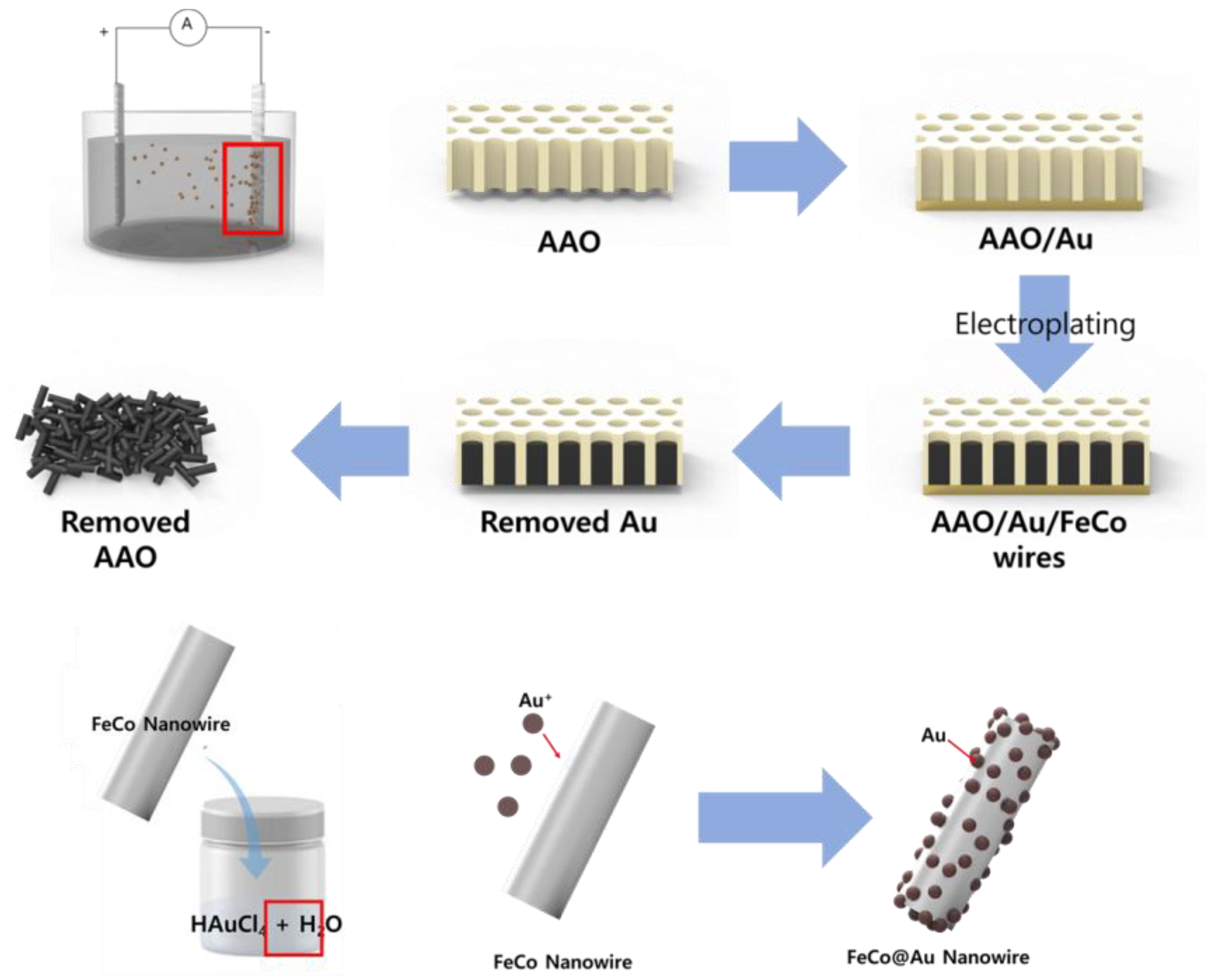

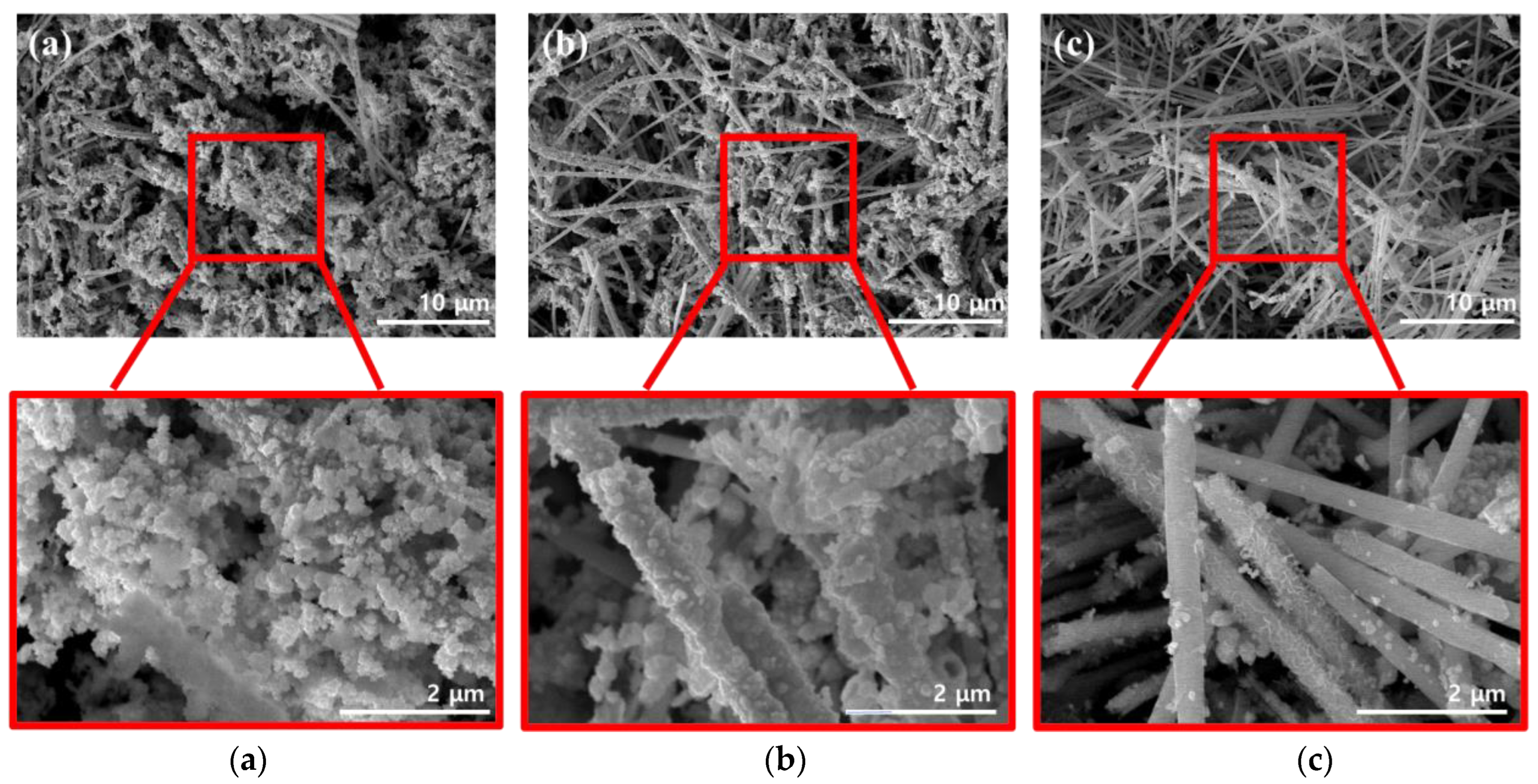
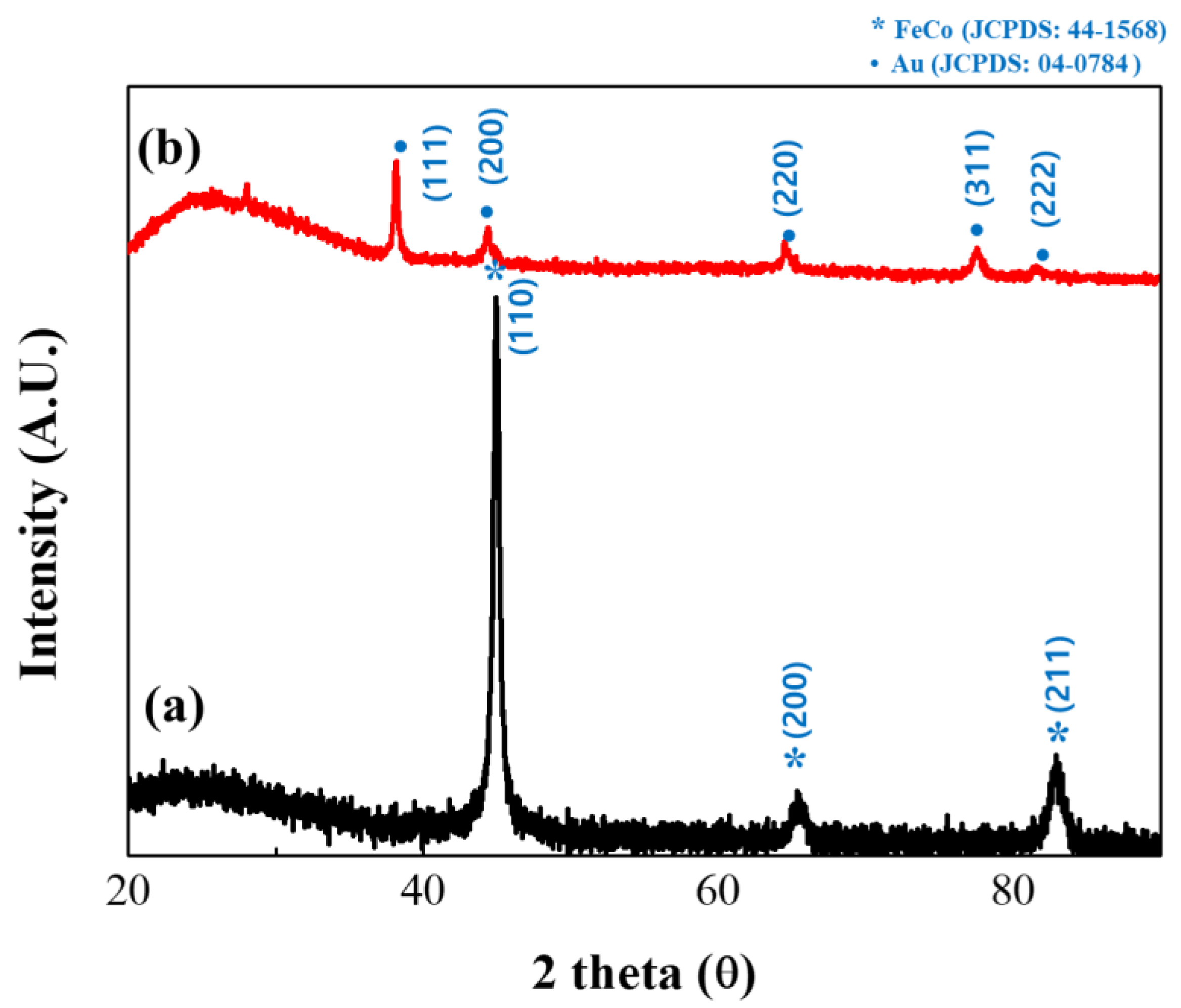
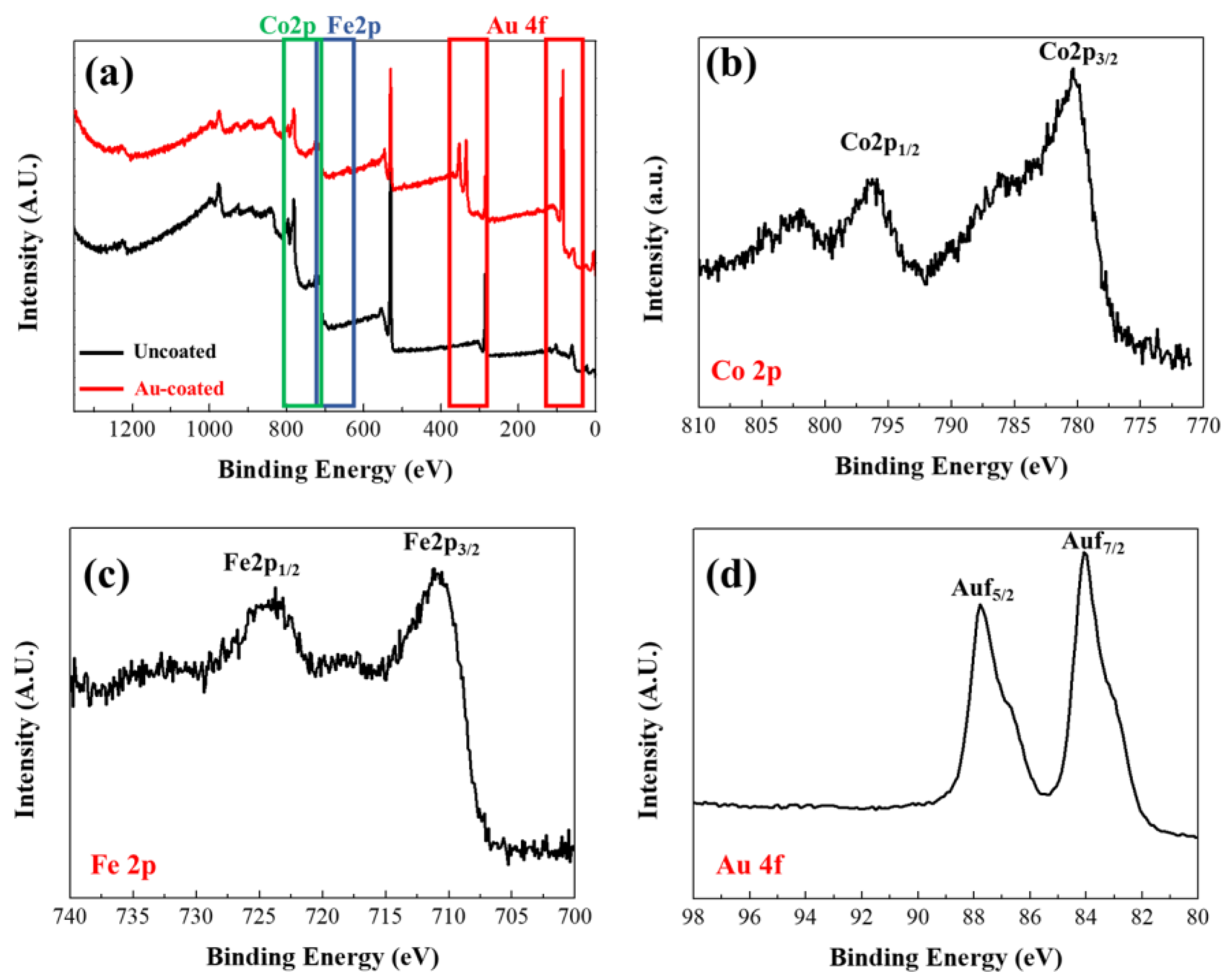
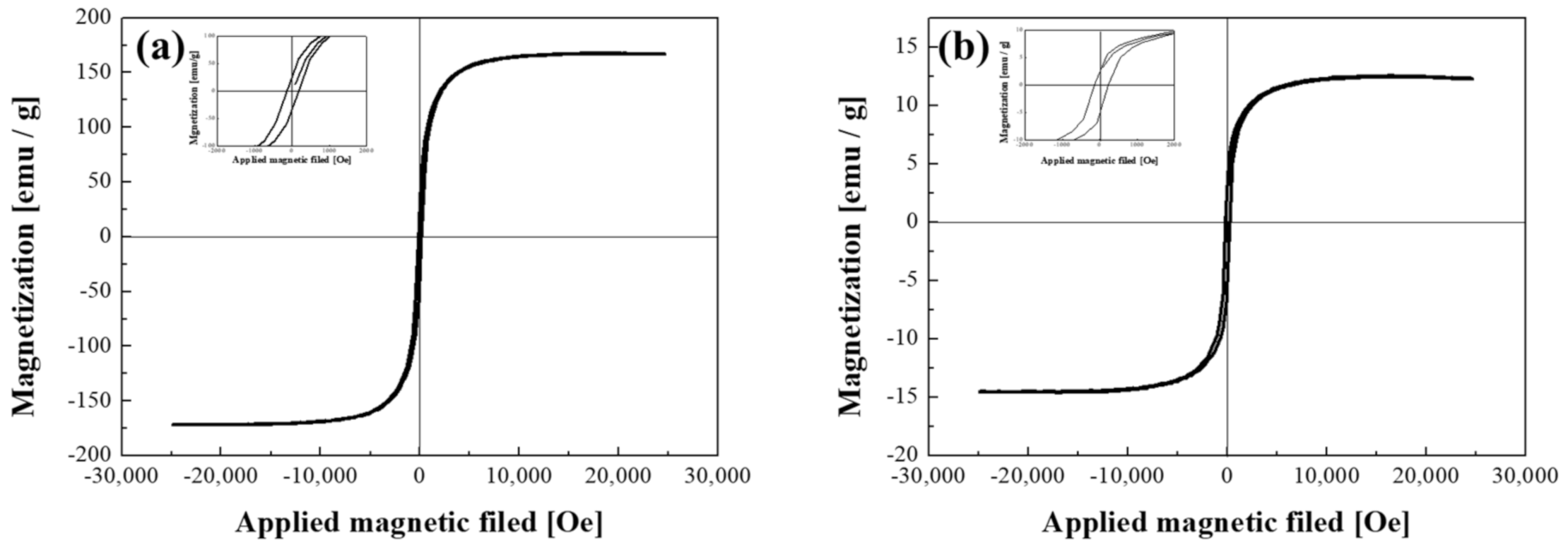
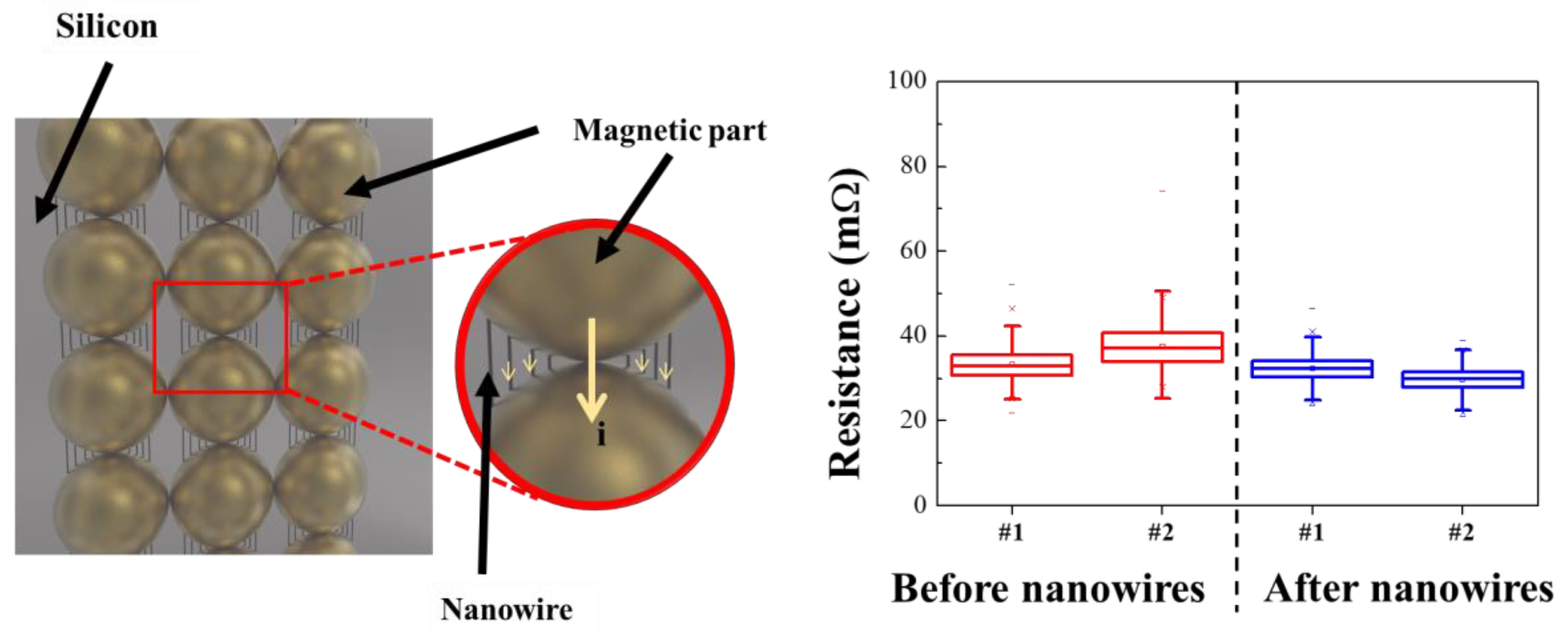
| Method | Morphology | Fe:Co [at.%] | Ms [emu/g] | Refs. |
|---|---|---|---|---|
| Chemical method (such as co-precipitation and chemical reduction) | Powder | 50:50 | 207 | [45] |
| Nanocubes | 50:50 | 211.9 | [46] | |
| Hollow spheres | 48:51 | 169.35 | [47] | |
| NWs | 60:40 | 92 | [48] | |
| Laser additive manufacturing (such as laser-engineered net shaping) | Film | 40:60 | 201.7 | [50] |
| Film | 30:70 | 199.3 | ||
| Electrodeposition | Nanotubes | 50:50 | 100 | [51] |
| NWs | 49:51 | 176 | [52] | |
| Electrodeposition (Present study) | NWs | 46:54 | 167.2 |
Disclaimer/Publisher’s Note: The statements, opinions and data contained in all publications are solely those of the individual author(s) and contributor(s) and not of MDPI and/or the editor(s). MDPI and/or the editor(s) disclaim responsibility for any injury to people or property resulting from any ideas, methods, instructions or products referred to in the content. |
© 2022 by the authors. Licensee MDPI, Basel, Switzerland. This article is an open access article distributed under the terms and conditions of the Creative Commons Attribution (CC BY) license (https://creativecommons.org/licenses/by/4.0/).
Share and Cite
Kim, I.Y.; Kim, J.W.; Lee, B.J.; Lim, J.-H. Fabrication and Characteristics of a Conductive FeCo@Au Nanowire Alloy for Semiconductor Test Socket Connectors. Materials 2023, 16, 381. https://doi.org/10.3390/ma16010381
Kim IY, Kim JW, Lee BJ, Lim J-H. Fabrication and Characteristics of a Conductive FeCo@Au Nanowire Alloy for Semiconductor Test Socket Connectors. Materials. 2023; 16(1):381. https://doi.org/10.3390/ma16010381
Chicago/Turabian StyleKim, In Yea, Jong Won Kim, Byeung Ju Lee, and Jae-Hong Lim. 2023. "Fabrication and Characteristics of a Conductive FeCo@Au Nanowire Alloy for Semiconductor Test Socket Connectors" Materials 16, no. 1: 381. https://doi.org/10.3390/ma16010381
APA StyleKim, I. Y., Kim, J. W., Lee, B. J., & Lim, J.-H. (2023). Fabrication and Characteristics of a Conductive FeCo@Au Nanowire Alloy for Semiconductor Test Socket Connectors. Materials, 16(1), 381. https://doi.org/10.3390/ma16010381






